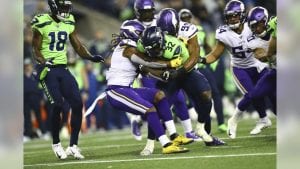Cracks in Vikings Run Defense

The Minnesota Vikings defense is crumbling before our eyes.
And the cracking begins on first down.
The Vikings have gone 2-2 in the last four weeks and although they have a clear path to the playoffs with an 8-4 record, there is cause for worry in Eagan Minnesota. Early in the season, Minnesota hovered among the top five defenses in the league. Entering Sunday’s game with Detroit, they are officially average, sitting at 16th in average-yards allowed in the 32-team NFL.
Midway through the season, the Vikings were 6-2 and had an extended break after beating Washington 19-9 on Thursday night football. At that time, the Vikings allowed 89.4 yards rushing per-game and 313.9 yards per-game overall. Good numbers for a good defense.
After Monday’s 37-30 loss to Seattle, those benchmarks reveal a defense that has lost its lust. The Vikings now surrender 347.4 yards per-game and 104.5 yards a game on the ground.
The fractures in the foundation of the Vikings’ defense appear when their opponents run the ball on first down.
In the last four games, the Vikings have given up 539 yards rushing, or 134.75 per contest. On first-down runs in those games, opponents have hammered out 270 yards on the ground in 61 attempts, almost 4.5 yards per carry.
Yep, offensive coordinators have discovered when they run the ball against the Vikings on first down, the Vikings can be blasted off the scrimmage line. Minnesota opponents have gained four or more yards on 39 of those 61 first-down runs. Said differently, there’s only a 36% chance Vikings’ foes won’t gain at least four yards when they elect to begin a new set of downs with a running play.
Last Four Games
Let’s take a closer look at the last four games.
Kansas City, which beat the Vikings 26-23, gained 39 yards on 10 first-down runs. Six of those first-down runs netted them four or more yards. The Vikings surrendered 147 yards rushing to Kansas City that day on 18 attempts; Damien Williams’ 91-yard TD pop came on a second-down run.
The Vikings focused on stopping Ezekiel Elliot when they rolled into Dallas a few weeks ago. Overall, they succeeded, limiting Dallas to 50 yards rushing on 22 carries. But most of Elliot’s yards came on first-down runs; he gained four or more yards on seven of the team’s 16 first-down run attempts. The Vikings’ defense hung on, however, as Minnesota won 28-24.
In Minnesota’s 27-23 win over Denver, the Broncos started 16 of their 28 first downs on the ground. Those 16 runs netted 70 yards, and 10 of those runs gained four or more yards. By running the ball successfully, especially on first down, the Broncos were able to control the ball for 36:43 of game time.
Seattle noticed the trend, and on 19 first downs, the Seahawks chose to run at the Minnesota line. It worked: Seattle gained 122 yards on 19 first down rushes. 13 were for four or more yards, helping Seattle control the ball for 39:45 during the game. It’s funny what those second-and-short situations do for the concept of ball control. Seattle ended up with 218 yards on 43 rushes and won 37-30.
It’s Pile On Xavier Rhodes Week in Minnesota, but I’m taking a pass. While Rhodes and his fellow DB’s sometimes are called upon to stop running attempts, the defensive lineman and linebackers need to reclaim their reputation as a unit of nasty tacklers. Whatever the front seven has to do to lasso the lust to hammer running backs, they need to do it beginning Sunday. The season is now a four-game thing.
So over the next four weeks, let’s watch Linval Joseph, Shamar Stephen, Jaleel Johnson, Jayln Holmes, Everson Griffin, Danielle Hunter, Stephen Weatherly, Ifeadi Odenigbo, Armon Watts, Eric Wilson, Eric Kendricks, Anthony Barr and Hercules Mata’ afa.
If they again take away the run on first down, the Vikings can achieve every goal they have in 2019.
Photo Credit: Abbie Parr/Getty Images
